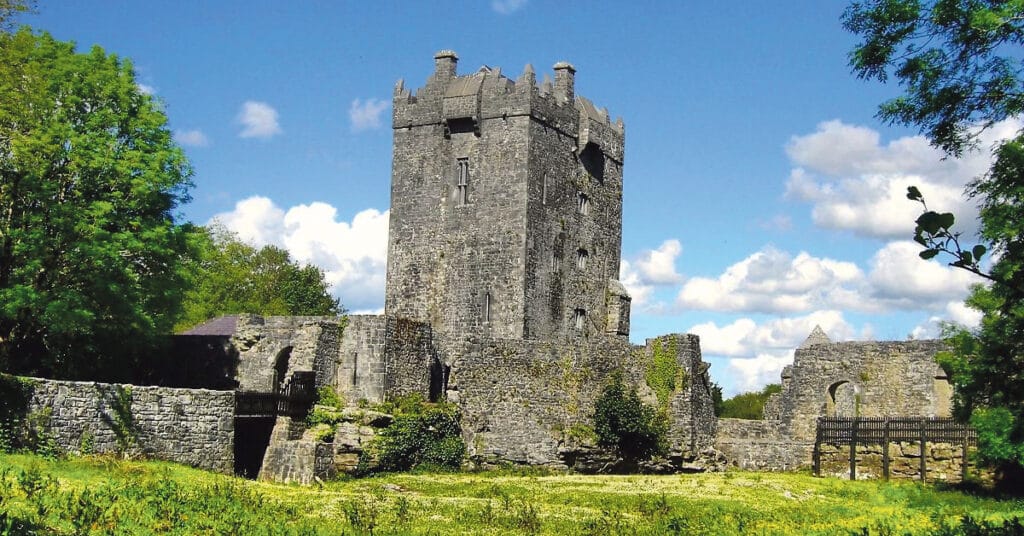
One of the more positive aspects to emerge out of this global pandemic has been a greater appreciation and discovery of one’s locality, county and even country. Previously hidden beauty spots are now being explored and utilised and there has been a phenomenal switch to this lifestyle in the last eighteen months. And although we have so many amazing historical museums dotted around the country, there are many historical outdoor gems waiting to be discovered too. It was on one such staycation this summer in Connemara that I stumbled across some of these hidden jewels that combined the splendour of the countryside with a twist of historical interest.
The sky always seems much bigger in the west of Ireland. Perhaps it is because the sinking sun sets over the sea that far north and west, which combines to lengthen the day and widen the horizon. Perhaps it is the stretches of wild emptiness that makes you feel you are alone on the planet, the tranquillity that somehow enhances the sounds of nature. All of this and more are hypnotic qualities and reason alone for any trip to the west of Ireland. But there is the secret historical lore too. The endless tiny fields with nothing but stone walls. It’s as if, as my father used to say, the soil was so bad, you could only grow stones. While there’s no doubt our forefathers had to painstakingly clear the land to conjure a tiny tract of semi arable land, there is more to these ditches too. Many were built from the leftover stones of the empty famine ruins that littered this part of the world, like a ghoulish spectre.
Embarking on this trip, one has to carry a sense of curiosity, and oftentimes take the path less trodden. A few miles south of Oughterard in Galway, we noticed a turn off with a sign for Aughnanure Castle (Derived from the name – field of the Yew Trees). Though it wasn’t on our radar, we ventured for a look. It was a worthwhile detour. This 15th century Tower house on the edge of Lough Corrib is one of the finest and best-preserved tower houses of this period. The castle is enclosed within the inner bawn walls. It seems to have been constructed upon the foundations of natural rock, which elevates the grounds making it all the more impressive. Below is a moat and river on one side and, as we learned, the lake had previously flanked the other side, until modern times when some of the land was reclaimed around it. The O’Flaherty tribe built here, on the edges of Lough Corrib, after the Norman invasions spread west from Leinster. It was the De Burgos who ejected them from their stronghold, which we now call Galway City. In an era where land travel was difficult, underdeveloped, and dangerous, access to Lough Corrib was essential. We later got to appreciate just this when viewing the length and breadth of Lough Corrib from the top of one of the Maumturk Mountains. It was a breathtaking vista, capturing a flotilla of different shaped islands, dotting the waters all the way to Galway City.
On the ordinance survey map for Connemara there is a trail that runs, oftentimes in long, straight lines, all the way from Clifton to Galway. Today it rumbles over parts of the road, the western way hiking trail and farms. This was the route of the former Clifden to Galway train route, which lays claim to being one of the most picturesque train routes in Europe and it is easy to see why. Time and time again, modern generations have lamented at our government’s decision to pull up the rail infrastructure that had linked our cities with some of the most rural places in Ireland. Economics and the popularity of road travel are cited as the practical reasons for doing so, but what would Ireland be like today if someone had the foresight to maintain them? Many of the greenways today in the most picturesque spots in Ireland like the greenways in Courtmacsherry, Dungarvan and Westport would have been magical to visit on a train. Imagine the benefits to rural communities and the international appeal, to travel on the most breathtaking train rides in Europe? I witnessed at Maum Cross, one of the best-preserved rural infrastructures I have seen, of that era. On the edge of the road that swings north to Leennane, is a former station of the former Midland Great Western Railway Company. In 1889, the British Government gave a huge grant to the company to build a route linking Galway to Clifden. Today, we are told by successive governments that it isn’t viable to create infrastructure in sparsely populated areas but the British Government at the time passed the 1889 Light Railway Act to overcome this. This spurred on fifteen major rail projects into rural, non-commercially viable routes and also was a stimulus for employment in areas that were deemed poor regions such as Connemara. Track, viaducts, bridges and tunnels were all built for what turned out to cost 9,000 pounds a mile, as opposed to the usual 3,000 pounds a mile for railway lines. However, in an era when most people lived alongside the coast in fishing villages, it was not very practical running it through the centre of Connemara. Today the railroad would draw millions of visitors, but unfortunately, it only lasted from 1895 to 1935. At Maum Cross, it briefly comes alive. There is a fine stretch of track preserved, with the ruins of a station house. You can also see a signal tower and equipment, and the implements for changing the track lines, as well as other smaller features. Your imagination quickly fills in the blanks standing in the blissful tranquillity of Connemara.
On the outskirts of Clifden, in the peat bogs around Derrigimlagh, only the remains of one of Ireland’s greatest ever technological sites now stands. Up here at the turn of the 19th century in what seemed a million miles from the centre of civilization, Guglielmo Marconi built his wireless telegraphy station powered by the masses of peat that surrounded the plant. Many of us in West Cork may be familiar with a ‘Marconi signal tower’ on Brow head near Crookhaven and indeed West Cork is part of this narrative. The wireless telegraphy station was completed at this spot by 1907. It wasn’t the only Marconi Tower operating from Ireland but it was the most powerful. It could communicate and send message with another Marconi Tower built in Glace Bay, Nova Scotia, Canada. The site had to house employees, a power station, and a receiver for ‘returning messages’ that had to be constructed at a distance from the power station, such was the noise generated when operating the system. It is recorded that people in the region would regularly gather outside each other’s house to gaze, mesmerized, at the fantail of enormous sparks that lit up the sky, as the Marconi tower sparked into life with a thundery boom. Sadly, today little to nothing of it remains due to the activity of the Republican IRA and the inertia of the Irish Government from 1923. One of the scars of Ireland’s Civil War (1922-23) was the destruction of infrastructure, some which never recovered. What some saw as strategic targets, to others was an act of wanton vandalism. The destruction of large sections of the Marconi station by the local Republican IRA damaged it to such a degree that it was no longer operational. Marconi applied to the Free State government for compensation to rebuild it. After he was turned down, the station never was returned to its former glory, and like our great train stations, it crumbled or was sold for scrap. Yet a trip to the former site is a must. A designated trail brings you five kilometres along an old track complete with information boards, photographs and audio tracks that help one to reimagining what the remains looked like. One can recreate the huge condenser house building, the powerhouse with its six boilers, and massive aerial system consisting of eight wooden masts. The aerials emitted 150KW at 15,000 volts – all this in the wilds of Connemara on the edge of the world. It truly must have been a sight to behold.
What adds to the allure of the site, and is also represented here, is the landing of Alcock and Brown. These pilots won an international competition to see who could cross the Atlantic Ocean on a nonstop flight. In 1919 they managed the 1,900 miles crossing in sixteen hours. Although their landing destination was not the power station, incumbent weather and faltering mechanics forced them to look for an alternative spot. The massive aerials of the Marconi station acted like a beacon for the men who landed softly in the blanket of peat bog. If the crossing wasn’t historic enough in itself, the operators at the Marconi tower were in the privileged position to relay the news back across the Atlantic about the success of these intrepid adventurers. The story of these men and their successful crossing (earning them the equivalent of a million pounds today in prize money), is very much included in the history of the site at Derrigimlagh. This outdoor gem of an open museum, infused by the smell of the peat bogs and the sounds of the rolling waves of the Atlantic, is enough to entice anyone who wants a staycation with a historic edge, to venture into the west. Hope you get there.



